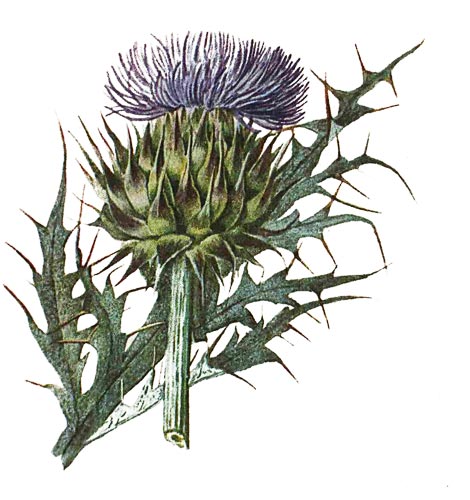Weeds
Carduus nutans L. - Nodding Plumeless Thistle, Musk Thistle
Systematic position.
Family Asteraceae, genus Carduus L.Synonyms.
Carduus coloratus Tamamsch., C. kondratjukii Gorlacrova, C. nutans var. armanus Boiss., C. schischkinii Tamamsch., C. songoricus Tamamsch., C. thoermeri Weinm. subsp. armanus (Boiss.) Karmi.Biological group.
Biennial or perennial weed.Morphology and biology.
The plant is 25-100 cm in height, rigid-spiny. Root fusiform. Stalk simple or ramified at the top, web-pubescent, costate, winged. Leaves alternate; lower ones 6-30 cm in length, 2-6(10) cm in width, pinnatisect, narrowed at base in short petiole; the others sessile, elongated with serrate margin; each dent terminates in a long pointed rigid prickle; the leaves decurrent at base, forming emarginated-serrate spiny wings. The leaves glabrous on both sides or bearing sparse wavy hairs from below along ribs. Calathidia single, drooping, large, 3-6 cm in diameter, flattened-spherical. Flower peduncle long, non-winged, pannose-pubescent. Involucre with glabrous leaflets; both outer and middle leaflets ovoid-lanceolate at base, strangulated at middle, bent outward, terminating in a lanceolate-subulate prickle. Corolla bright crimson, purple, occasionally white. Hemicarps elongated, 3-4(5) mm in length, slightly narrowed toward base, with thin longitudinal strips and with pappus being shorter than corolla. Blossoms from mid-June until August. Fruitfulness to 12,000 hemicarps.Distribution.
Almost all Western Europe, Northern Africa, Asia Minor, Iran, Afghanistan, Southwest China. In the territory of the former USSR the plant is distributed in the northwestern, middle, and southern strips of the European part, in the Caucasus, Western Siberia, and Central Asia.Ecology.
The plant grows on dry pastures, common at roads and on waste grounds, abundant on black-earth soils.Economic significance.
The weed meets in fields with grain and oil-bearing cultures, grasses, in gardens and vineyards. It is nocuous in perennial grasses and newly developed lands. Control measures include obligatory stubbling after harvest, autumn plowing, bare fallows, due treatment of soil and crops, destruction of the weed on uncultivated places, application of herbicides if necessary.Reference citations:
Artokhin, K.S. 2004. Atlas of weed plants. Rostov-na-Donu: Kniga, 144 p. (in Russian).Keller, B.A., ed. 1934. Weed plants of the USSR. V. 1. Leningrad: AN SSSR. 324 p. (in Russian).
Keller, B.A., ed. 1935. Weed plants of the USSR. V. 4. Moscow & Leningrad: AN SSSR. 416 p. (in Russian).
Shishkin, B.K., ed. 1965. Flora of the Leningrad Region. V. 4. Leningrad: LGU. 356 p. (in Russian).
Vasilchenko, I.T. & Pidotti, O.A. 1975. Keys to weed plants of areas of irrigated agriculture. Leningrad: Kolos. 375 p. (in Russian).


